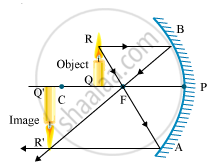Advertisements
Advertisements
प्रश्न
A student wants to project the image of a candle flame on a screen 48 cm in front of a mirror by keeping the flame at a distance of 12 cm from its pole.
(a) Suggest the type of mirror he should use.
(b) Find the linear magnification of the image produced.
(c) How far is the image from its object?
(d) Draw ray diagram to show the image formation in this case.
उत्तर
(a) He should use a concave mirror, as it forms a real image on the same side of the mirror.
(b) Object distance, u = -12 cm
Image distance, v = - 48 cm
The minus sign in magnification shows that the image formed is real and inverted.
(c) The image is formed at a distance of 36 cm from the object.
(d)

In this case, the image is formed beyond the centre of curvature. This image is real, inverted and enlarged.
APPEARS IN
संबंधित प्रश्न
An object of height 5 cm is placed perpendicular to the principal axis of a concave lens of focal length 10 cm. If the distance of the object from the optical centre of the lens is 20 cm, determine the position, nature and size of the image formed using the lens formula.
Draw a ray diagram to show the path of the reflected ray corresponding to an incident ray of light parallel to the principal axis of a concave mirror. Mark the angle of incidence and angle of reflection on it.
A concave mirror produces three times magnified image on a screen. If the object is placed 20 cm in front of the mirror, how far is the screen from the object.
One of the following does not apply to a concave mirror this is:
(a) focal length is negative
(b) image distance can be positive or negative
(c) image distance is always positive
(d) height of image can be positive or negative
A bright object 50 mm high stands on the axis of a concave mirror of focal length 100 mm and at a distance of 300 mm from the concave mirror. How big will the image be?
If a concave mirror has a focal length of 10 cm, find the two positions where an object can be placed to give, in each case, an image twice the height of the object.
How can a concave mirror be used to obtain a virtual image of an object? Draw a diagram to illustrate your answer.
The mirror used by the ophthalmologist to examine the eye is _______.
Pick out the concave and convex mirrors from the following and tabulate them.
Rear-view mirror, Dentist’s mirror, Torchlight mirror, Mirrors in shopping malls, Make-up mirror.
Under which of the following conditions a concave mirror can form an image larger than the actual object?
